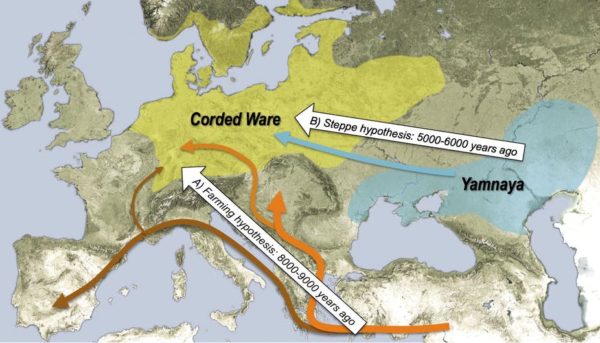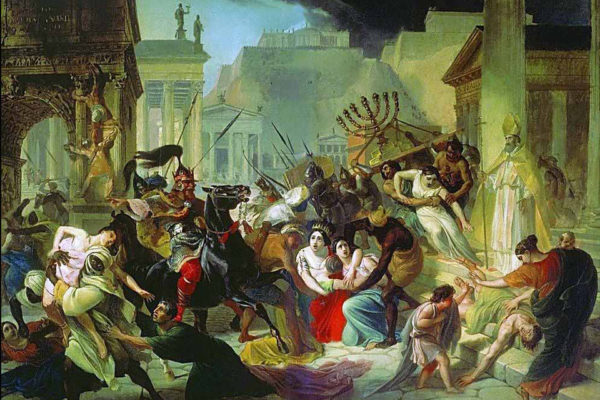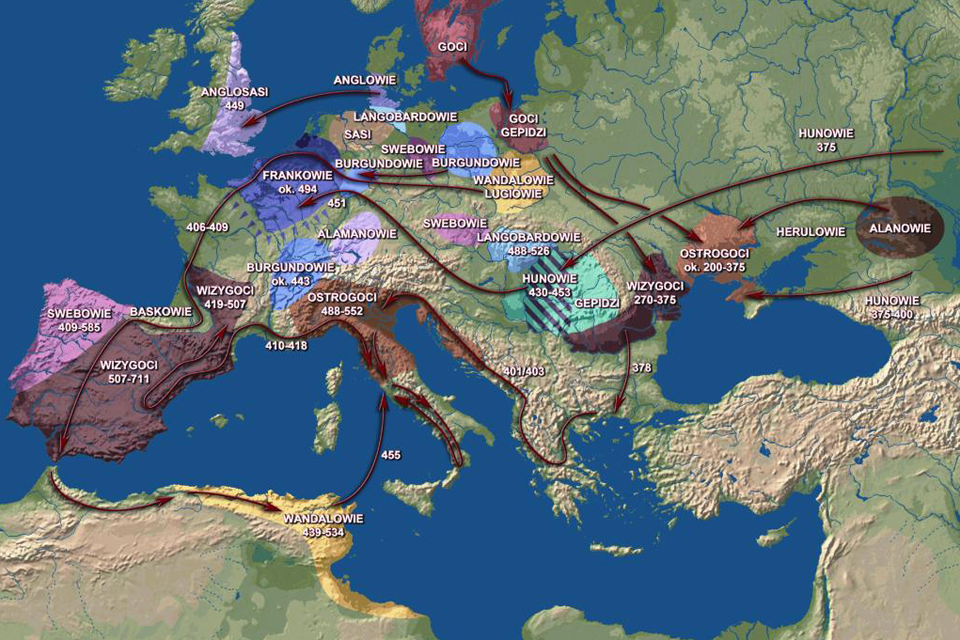Is a shift in “culture” the result of local evolutions or the meeting up of people? And how does such “meetings” play out culturally? Since the “invention” of new archaeology, this question has caused multiple controversies among archaeologists as well as historians. New aDNA studies lead the way to document the actual character of migratory movements. And with them, we gain a better understanding of how cultures might change.
As always, ground-breaking theoretical shifts inside archaeology are not formed inside “Medieval Archaeology”. Rather, they spring from Prehistory. Obviously, the lack of (disturbing) texts makes it easier to refine a model and use it as a theoretical tool. Afterwards, such tools are important for anyone aiming to rethink later events, as for instance the migration period, c. 400 – 600. While we are shedding the cobwebs of the 20thcentury academia, it pays to look at recent theoretical and methodological advances in prehistorical archaeology based on analyses of aDNA.
Migration studies and aDNA

Already in 2015 scientists published results demonstrating the extensive and sudden incoming of a gene flow carried by the Yamnaya people characterised by a pastoral economy. These events, which took place c. 3300 – 2600 BC led to a widespread process of genetic admixture with the indigenous Neolithic people in temperate Europe. What facilitated the events remains open to speculation. Was it pull into a depopulated northern Europe or a push facilitated by a newly invented transport-technology, the taming of horses? Whatever, the reason for the migratory movement it led to the formation of the Corded Ware Culture characterised by battle-axes, new types of pottery, slash-and-burn agriculture and the creation of steppe-land for grazing herds. Added to this new landscape were the traditional burial rituals with close affinities to that of the Yamnayas (single inhumations under barrows).
Another piece of the puzzle is the hybridisation of language between the remnant Neolithic populations and the new Yamnaya/Corded ware settlers. The settlers simply adopted a bundle of linguistic terms on non-indo-European origin, which were linked to agriculture. From this, we can conclude that the new-comers, who were pastoralists, did not know of farming and agriculture giving rise to a widespread adoption of local terms for the new type of economy adopted by the incoming pastoralists.
This cultural shift did not take place overnight. Rather Corded Ware Cultures co-existed with the former Neolithic Funnel Beaker communities, causing a gradual process of acculturation and integration lasting for a period of more than 500 years. On the road towards this new situation, archaeologists have now found solid evidence of groups of people practising widespread exogamy (as documented by studies of aDNA and strontium isotopic analyses). Thus, the Neolithic females furnished the new hybrid culture with a linguistic heritage of “agrarian” words and the new corded ware, while the migrant males furnished it with the traditional burial rituals of the nomads and – perhaps – the battle axe.
New Theoretical Model
This story of prehistorical genetic and cultural admixture leads us to see the contours of a social process of hybridisation and cultural integration formed by the mingling of incoming Yamnaya males marrying Neolithic women, but with the male warriors dominating the new settlements. The last bit is witnessed by the introduction of a tradition for male warrior burials in the former neolithic landscape.
“This integrated model of cultural, linguistic, and genetic change explains the formation of Corded Ware Culture as a result of new adaptations and of interaction between the migrant Yamnaya populations and indigenous Neolithic cultures”, writes the Kristian Kristiansen in a recent overview of the new studies, stressing the exogamic practice providing the integrating mechanism.
“Some may not like it for its resemblance to an older paradigm of migrations as a primary cause of cultural change… but we are now in a position to unravel the complexities behind the historical processes in much detail, and thus avoid the simplistic models of the past”, he and his co-authors in conclude.
Back to the Early Middle Ages

As was already pointed out by the German Archaeologist, Stefan Burmeister in 2016, this model of the cultural interplay between the migrating Yamayas and the Indigenous Neolithic people is valuable, while we ponder the events of the Migration Period (4thto 6thcenturies). In a seminal article on Archaeological Research on “Migration as a Multidisciplinary Challenge”, he outlined the consequences of these prehistorical studies for the understanding of the role of migration in the formation of Early Medieval Europe as a distinctly different cultural world than that of Late Antiquity. And noted that the opening up of archaeology and medieval history to genetics surely would yield a better understanding of the size, impact and cultural changes evolved in the movement of people during this period. The background for these reflections was – as is set out in the article – the fact that for a long time academically (read: politically), it was unacceptable to acknowledge that any significant migration did take place in the so-called migration period. Already outlined in the magisterial article by Heinrich Härke in 1998, the pacifist ideas of the cultural leftists continue to linger in the debate.
Further, the received wisdom was that to the extent migration could be ascertained to have taken place, it should either be considered the result of a limited recruitment of so-called barbarians to the Roman Army where they were “romanized”. Or in the case that mass migrations did take place, these people who were on the move, were not characterised by specific cultural outlooks and ways of life. Rather they should be seen as fluid groups of people with constant shifting outlooks and ancestry. It was only later these “barbarians” began to partake in the process of ethnogenesis (the formation of people in the 7th Century based on law and a barbarian reinvention of a (non-existent) tradition.) Either or, the idea that migrating people set their mark on Early Medieval Europe had for decades no academic traction.
We now know from Prehistory, however, that migrating people do not just get subsumed. They come, outfitted with a specific cultural outlook and a distinct cultural habitus. In the long run, they set their mark to the extent that they are able to accrue political power. We also know that a steady trickle of studies of aDNA from migration period burials demonstrates, that indeed, people migrated in large numbers. and that, yes, some correspondence may be found between the genetic ancestry of a dead person and the furnishings of his or her grave. As yet, it is still early days. Recently, however, significant studies were published concerning the genetic profiles of Bajuvarii and Longobards, the evidence for the practice of exogamy, and their distinct material culture.
We might say, that the hopes and expectations, which Burmeister voiced in 2016 are in the process of coming through.
The Fluid or Fixed patterns of Culture
In fact, these conclusions fit extremely well with what we now know from modern anthropologists and sociologists. Inside sociology and anthropology, two ideas have competed, when we wish to understand how “culture” works. One is the model where culture is understood as a “tool-box” of options available to us according to the situations and contexts, in which we find ourselves. This is the “postmodern” understanding, which was promulgated in the second half of the 20th century to facilitate the general idea that people are not fixed in their cultural outlooks, but rather have the option to develop new ways of living and thinking as life passes by. Among early medieval historians, this is often crystallised into a dictum whereby identity and ethnicity are at best considered multi-layered, situational and dynamic. So to speak negotiable. The other explanation is culture as a habitus, a set of ingrained ideas of how it is proper and correct to operate in a given context. These ideas were primarily developed by Pierre Bourdieu, but the work of Mary Douglas and Aaron Wildavsky should also be mentioned in this connection.
But who will have the final say? Do we incessantly negotiate our worldview and our cultural leanings? Or do we “carry” a burden of a specific habitual way of living, which we have difficulty in escaping?
Now, modern sociological studies have demonstrated that, indeed, it is the latter theory which holds up. Our lives are primarily ingrained in “habits of the heart”. This is not to say that we don’t possess some possibilities for wriggling free. Mostly, though, our culture is like an elephant, which we ride. Not easy to redirect down a new path. It takes major rethinking and reflection, and often only happens when we have an epiphany. This is the general conclusion reached by one of the more inspiring sociologists, Stephen Vaisey, who has studied the morals of youngsters and found that even when growing up, outlooks do not change over time. He has convincingly demonstrated that such ingrained cultural outlooks – diverse as they may be – to a large extent are responsible for certain wilful actions of youngsters when choosing to do drugs or not. After the fact, though, their “cultural explanations” may vary.
Which only goes to show that in general people do not live in such fluid and postmodern creative contexts as some early medievalists like to think. Even if people are on the move, they still ride their “culturally endowed elephants”. When Guy Halsall in a recent iteration of his academic posture writes that Roman Identity never was “an immutable or monolithic identity – like any other identity it never could”, he is basically recycling a political conviction, which no longer fits the scientific facts. It may be nice to think that we may change our “cultural colour” as chameleons as Jean Baudrillard, Jaques Derrida, and Roland Barthes (among others) tried to convince us about. The fact, nevertheless, remains that this is not how people go about making choices when planning to act out their lives. Rather, they dig into their cultural habits, ingrained in their habitus, and work from there. After the fact, they may colour it all rose-tinted, but that is quite a different matter.
To conclude: migrations do take place. When people move around, they carry with them a certain cultural outlook, which identifies them (or lets us identify them). This leads to “battlegrounds” characterised by cultural posturing as well as (occasionally) war. The end result in the case of prehistory was the formation of a new culture, that of the “Corded Ware”. In the migration period, it led to a genetic and cultural admixture of “barbarians” and “locals”, the patterns of which we are only slowly coming to grips with.
SOURCES:
Re-theorising mobility and the formation of culture and language among the Corded Ware Culture in Europe.
By Kristian Kristiansen et al (2017).
In: Antiquity, Vol. 9, No. 356, pp. 334-347.
Massive Migrations? The Impact of recent aDNA Studies on our view of third millennium Europe
By Martin Furholt
In: European Journal of Archaeology 2017, p. 1 – 33
Archaeological Research on Migration as a multidisciplinary Challenge.
By Stefan Burmeister
In: Medieval Worlds 2016. No. 4, pp. 42 – 64
Archaeologists and Migrations: A Problem of attitude?
By Hainrich Härke
In: Current Anthropology, vol 39 (1998).
Reprinted in: From Roman Provinces to Medieval Kingdoms
By Thomas F. X. Noble, Routledge 2006, pp. 262 – 276
Motivation and Justification: A Dual-Process Model of Culture in Action.
By Stephen Vaisey
American Journal of Sociology Vol. 114, No. 6 (May 2009): pp. 1675 -1715
READ MORE:
One of the best – albeit dated – introductions to the academic debate concerning the character and impact of the migrations in the 4th – 6th centuries can be found in
From Roman Provinces to Medieval Kingdoms
By Thomas F. X. Noble
Series: Rewriting Histories.
Routledge 2006

